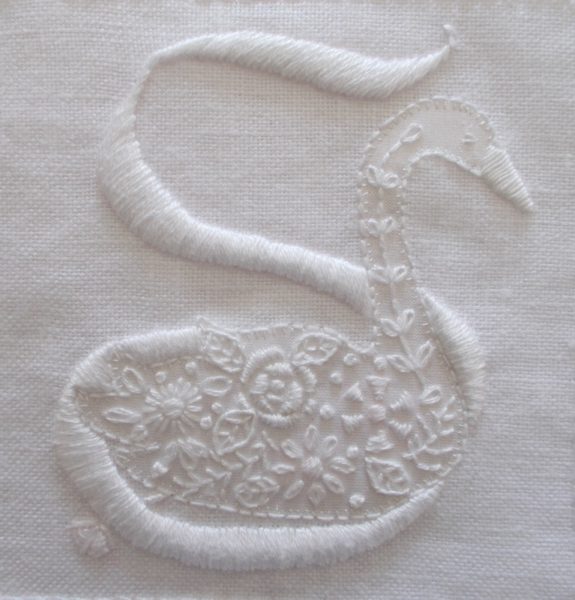
Whitework S for swan (hand embroidered by Mary Addison)
Edward Jenner is much celebrated at the moment as the man who pioneered vaccination for the successful treatment of smallpox. (A Gloucestershire man, he had a house in Cheltenham from 1792 – 1820.) But we should also remember Lady Mary Wortley Montagu who had brought a similar but less refined practice from the near east in the early C18th century, where the Turks practised variolation or inoculation using live the smallpox virus.* Edward Jenner’s genius later in the C18th was to develop the much safer technique of vaccination using a smallpox virus derived from the related and less deadly cowpox virus. The procedure was called vaccination after the Latin for cow, vacca.
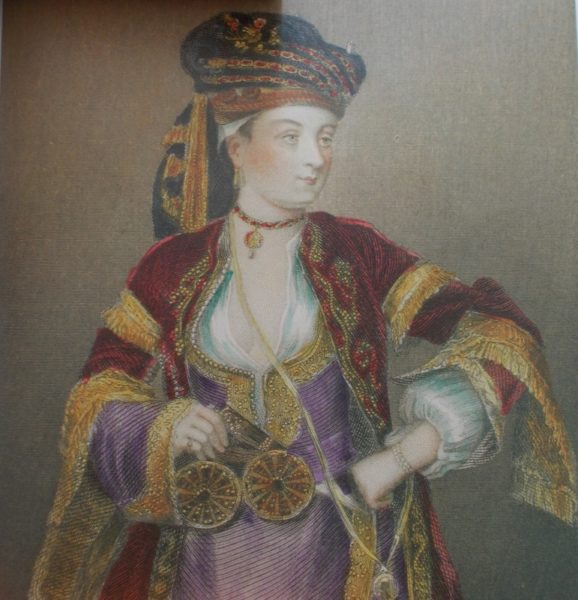
Lady Mary Wortley Montgu from a miniature in the possession of the Earl of Harrington, 1844, Jos. Brown, S.C. (from Selvedge Magazine May/June 2009)
I first encountered Lady Mary Wortley Montagu just after university when my future husband bought the recently published three volumed version of her Embassy Letters – letters written while accompanying her husband on his embassy mission to Turkey. I then fleshed out the rest of her life with Robert Halsband’s biography (he’d also edited those letters). Her early life had been spent as a member of the Pierrepont family in Thoresby Hall in Nottinghamshire. Before I went up to Oxford in 1970, I too a north Nottinghamshire girl, spent the summer working for an organisation mapping land usage in Nottinghamshire and remember coming upon Thoresby Hall on a dark, dramatic afternoon when thunder and lightening threatened and I had nothing except my map sheets and pencils to hand. I didn’t get very near the hall itself but thought that though Grade 1 listed, it didn’t look in a particularly good state; indeed it was only to remain in the Pierrepont family for another 10 years before being sold to the National Coal Board because of suspected underlying subsidence. (It was said locally to be cheaper to knock down houses suffering from severe subsidence than fill in the mine workings. For years, the house opposite the one I grew up in had cracks in the back garden down which my mother declared you could “lose a washing line prop” and sure enough, a few years later it was demolished.)
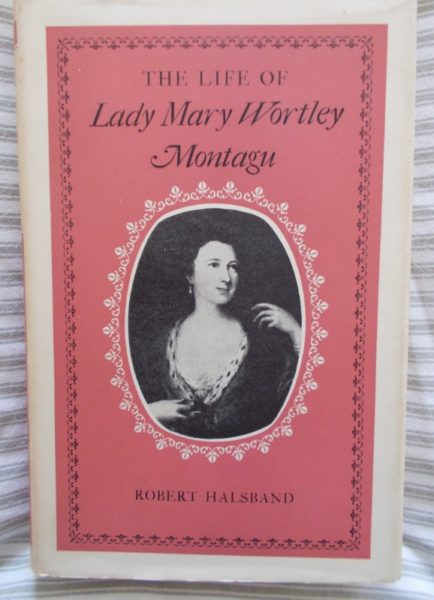
The Life of Lady Mary Wortley Montagu by Robert Halsband (pub. Oxford 1957)
Lady Mary escaped Thoresby (and a prospective marriage with the disastrously named Clotworthy Seffington) by eloping with Edward Montagu. She married Montagu, he became an MP and for a short while she enjoyed moving in court circles, having the ear of both of the king’s mistresses and holding her own in the salons with literary men like Alexander Pope and John Gay. Then smallpox struck. Her brother had died of smallpox in 1713 and though she recovered, by 1715 it was noted that she was left with deep pock marked skin, no eyelashes and a permanent blotchy redness around her eyes (which never left her). An unfortunate satyrical piece she’d written for private consumption while ill, thought to be about Princess Caroline, came into wider circulation, so when, fortuitously her husband was offered the ambassadorial post in Constantinople she broke with common practice and decided to accompany him on his mission, along with their young son. In Turkey, remarking how few women bore the signs of pitted and scarred skin, she witnessed for herself the practice of variolation or inoculation – the description of which leaves me slack jawed, mouth frozen in the act of forming even the first P of PPE:
“The small-pox, so fatal, and so general amongst us, is here entirely harmless by the invention of ingrafting, which is the term they give it. There is a set of old women who make it their business to perform the operation every autumn, in the month of September, when the great heat is abated.
…the old woman comes with a nut-shell full of the matter of the best sort of small-pox, and asks what vein you please to have opened. She immediately rips open that you offer to her with a large needle (which gives you no more pain than a common scratch), and puts into the vein as much matter as can lye upon the head of her needle, and after that binds up the little wound with a hollow bit of shell”
Letter from Lady Montagu to Mrs S.C., Adrianople, April 01, 1717
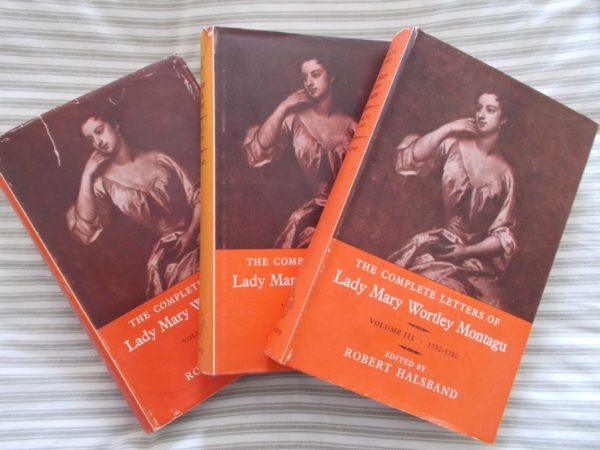
The Complete Letters of Lady Mary Wortley Montagu ed Robert Halsband (Oxford 1975)
Having discussed the process with the embassy surgeon Lady Mary had her 5 year old son innoculated in 1718. When the Ambassador was recalled to London shortly after, she became zealous in pushing the practice at home. During the smallpox epidemic of 1721, she had her daughter publicly treated in front of witnesses including the king’s physician. – the first time the procedure was carried out in Britain. (At this time 1 in 4 who caught smallpox died from it.) Caroline of Ansbach, Princess of Wales (who seems to have forgiven or forgotten past improprieties) was keen to have her children inoculated but her father-in-law George I would hear nothing of it until he had more evidence. Testing was the thing. The first group consisted of 6 (or 7) prisoners who were facing the death sentence in Newgate Prison. All survived and all, according to prior agreement, were released. The second test was carried out on 11 orphans. Results were sufficiently satisfactory that the king permitted his 2 granddaughters to be inoculated but not his grandsons! In 1768 Catherine the Great was inoculated along with her son.
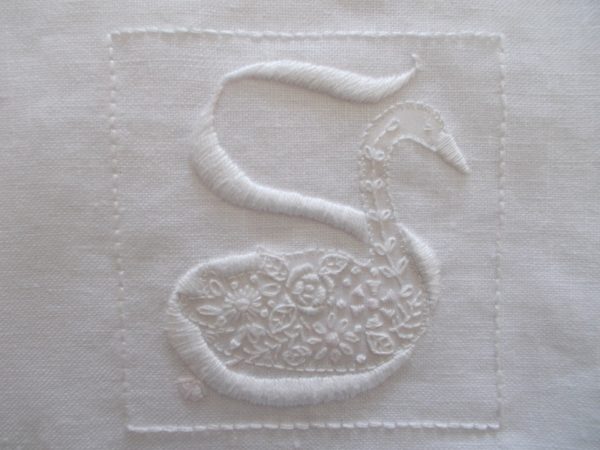
Whitework S for swan (hand embroidered by Mary Addison)
However, inoculation came with its own dangers. Some people went on to develop smallpox and died, while it seemed that those inoculated could be infectious to others or were carriers of the disease. As with many scientific advancements, at around the same time there were at least 5 individuals (both English and German) who had noticed that those infected with cowpox didn’t get smallpox. Jenner first tested his hypothesis in 1896 and he then went on to prove that cowpox inoculation gave immunity to smallpox. It took years for vaccination to be fully accepted and it was only in 1840 the British Government banned variolation (the use of smallpox) and made cowpox vaccination freely available. This all helps to put our expectations into perspective when considering when we might get a vaccine for Covid-19. Scientific advances move very quickly but we have to accept that testing takes time and has a lower limit that is probably longer than we would like.
While Lady Mary’s son was the first English person to undergo inoculation, Jenner’s procedure marked the first time in western medicine that induced antitbodies were used to produce immunity from disease.
*Interestingly in 1733 in his Philosophical Letters, Voltaire noted that the Circassians used the inoculation from times immemorial, and the custom may have been borrowed by the Turks from the Circassians.

8 Comments
I have to give a mention to our very own Benjamin Jesty of Yetminster, who was ahead of the game.
Indeed – he was vaccinating his family in the 1770s.
I hadn’t heard of Lady Mary’s contribution to the history of inoculation!
But now, I’m wondering about her rejected suitor, or more accurately, wondering what on earth his parents were thinking of!
This seems to explain things as to origin of the name though not as to taste in bestowing it. Clotworthy is an English surname named after the hamlet of
Clatworthy in Somerset.
(This) “impressive name came from John Clotworthy, a son of the High Sheriff of Antrim who backed the right horse during the English Revolution and was created Viscount Massereene and Baron Loughneagh. He had been succeeded by his son-in-law, John Skeffington, who had given his wife’s maiden name to his son as a forename. Thus the third Viscount was the first Clotworthy Skeffington. The fourth Viscount, named Clotworthy after his father, was most noted in history for being the rejected suitor of Mary Pierrepoint, later Lady Mary Wortley Montagu.” https://www.headstuff.org/culture/history/clotworthy-skeffington-eccentric-earl/
Another really interesting and educative post, thank you Mary. I expect you read Selvedge magazine but just in case you don’t know, there’s an article in this month’s edition entitled Timeless Chikankaari
which describes white on white embroidery
I do take Selvedge and I have read the article.
In fact I have a Chikankari cloth a friend brought back from India which I blogged about here and which you might like to see . http://www.addisonembroideryatthevicarage.co.uk/2016/01/27/whitework-chikankari-tablecloth/
Oh my goodness 1 in 4 got the disease? Those odds don’t seem worth the chance. I am rooting for the Oxfordians in the CoVid19 vaccine challenge, but I am also grateful that great philanthropists are backing multiple horses in this race.
I will miss seeing family but I’m not sure I’ll go to London again until we have a vaccine – so fingers are crossed that one of the trials produces something effective.